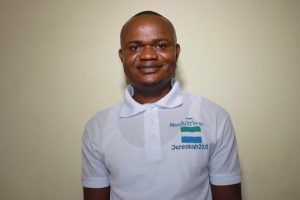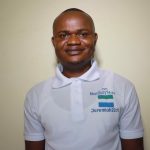The well in Makassa was installed by another organization in 2019, but it hasn't been functional since 2021. Just when the 372 people in Makassa thought their water crisis was over, they were back to square one, with no working water source and only the swamp to fill their water containers.
"The pump next to my house is not working," said 15-year-old Mariamah S (shown below fetching water). "It [has] not [been] providing water for too long now. This is the reason why I fetch water from the swamp."

The pump has been broken for almost a year at the time of writing (October 2022), and efforts by the community members to fix it themselves have been unsuccessful. They don't have the money to hire a specialist to do the repairs, and the organization that installed the well didn't provide any resources to help. Even when the borehole was functioning as intended, community members reported that the water turned brown with mud during rainy seasons.

So, unfortunately, community members have resorted to using swamp water for all of their water needs. Everyone in the community rushes to the swamp as early as they can in the morning, as the water grows opaque with dirt and sediment as the day goes on. But just because the water looks clean doesn't mean that it is safe to drink.
"I wake up very early in the morning to sweep the compound," Mariamah said. "I also rush to the swamp with other people to fetch water. It is difficult to fetch clean water from the swamp after many people had fetched water or there had been rainfall overnight. The water in the well could be filthy and not good to carry to the house for drinking. When I am at the swamp to fetch water in the morning, I could be worried about not getting late to go to school because I would be punished by my teachers if I am late for school."

The swamp pool was initially dug for farmers to use on their nearby farms. The farms use fertilizers and pesticides that flow through the fields and into the water. The swamp is open and uncovered, with frogs, grass, and other organisms floating in the yellowish water. Domestic and wild animals share the water source with humans, contaminating it further. And, perhaps worst of all: a nearby airport is expanding its operations, and the company hired to do the construction has not been very mindful of the chemicals and materials they are using.
"The operations of [the construction company] are causing a great pollution of the stream that is flowing from the top of the swamp to the community," said our field officer, Alie Kamara. "The flowing of the polluted water is contaminating the well at the swamp where the community people are fetching water to drink and for domestic purposes. This has again added another difficult challenge on access to clean water in this community."

38-year-old farmer and mother Nanah Turay (pictured above) knows the swamp isn't safe for her or her children. "It is frustrating to live in this community without safe drinking water. I have struggled so much to fetch safe drinking water. The only water well that we have [has] not [been] working for the past year.
"The [swamp] area is not safe, especially [for] my children. The swamp is not covered, and because of that, dogs, sheep, and goats can also drink water. I don’t think of the swamp water as good water for drinking. I can only get partially clean water from the swamp early in the morning. I must skip my morning prayers to fetch drinking water from the swamp before it [can] get dirty.
"During the time I was fetching water from the pump, it was better because the well is inside a fence and locked with a padlock. No domestic animals had access to enter the fence of the well. The major challenge of the well is the breakdown of the pump and the changes of the color of the water at the time of approaching the rainy season. During the rainy season, rainwater is the most available water that I collect to use for drinking and other domestic activities. I also store it for further use when there is no rainfall. This is helping me to have enough water at my house to use."
Community members reported many negative consequences from drinking this water, including skin rashes, cholera, typhoid, dysentery, and parasitic infection. People have also been bitten by snakes while fetching water in the swamp's tall grass.
We can fix Makassa's well so that those dashed dreams can be renewed. With safe, monitored water closer to home, people's health and schedules should markedly improve.
The Proposed Solution, Determined Together...
At The Water Project, everyone has a part in conversations and solutions. We operate in transparency, believing it benefits everyone. We expect reliability from one another as well as our water solutions. Everyone involved makes this possible through hard work and dedication.
In a joint discovery process, community members determine their most advantageous water solution alongside our technical experts. Read more specifics about this solution on the What We're Building tab of this project page. Then, community members lend their support by collecting needed construction materials (sometimes for months ahead of time!), providing labor alongside our artisans, sheltering and feeding the builders, and supplying additional resources.
Water Access for Everyone
This water project is one piece in a large puzzle. In Kenya, Sierra Leone, and Uganda, we’re working toward complete coverage of reliable, maintained water sources that guarantee public access now and in the future within a 30-minute round trip for each community, household, school, and health center. One day, we hope to report that this has been achieved!
Training on Health, Hygiene & More
With the community’s input, we've identified topics where training will increase positive health outcomes at personal, household, and community levels. We’ll coordinate with them to find the best training date. Some examples of what we train communities on are:
- Improved hygiene, health, and sanitation habits
- Safe water handling, storage & treatment
- Disease prevention and proper handwashing
- Income-generation
- Community leadership, governance, & election of a water committee
- Operation and maintenance of the water point

 Borehole Well and Hand Pump
Borehole Well and Hand Pump















